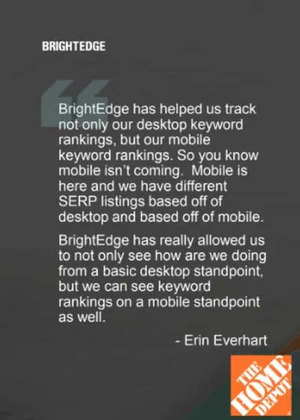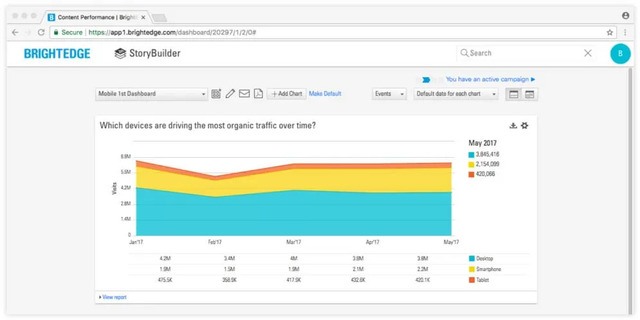It is no question that every business now has to consider their marketing strategies on all device types. Understanding how your customers engage with you throughout the buying journey, typically starts with research on a mobile device. For many industries, mobile traffic from organic has surpassed desktop traffic; the latest BrightEdge research has found that on average 57% of the traffic to your website now arrives from either mobile or tablet devices. Ninety-three percent of people who perform research on mobile devices will go on to make a purchase and mobile drives or influences over 40% of revenue for leading B2B organizations. In recent years, your customers are no longer just researching on their mobile devices, but are also starting to convert at higher rates on mobile. It has become critical to have a mobile-first strategy, and a mobile-friendly site. These mobile users want to see quality websites--mobile users who do make a purchase through their devices will visit the website for the brand an average of 6 times before they hit "buy." As the importance of paying attention to mobile users becomes clear, so too does the need to optimize specifically for customers on these devices. The mobile SERP has become increasingly contextual. In an effort to boost personalization, search engines use factors such as the person’s physical location when performing searches. The SERP can also differ greatly from desktop searches. Forty-seven percent of keywords in positions 1 to 20 rank differently on mobile versus desktop SERPs. This indicates that people need to create a mobile-specific optimization strategy. Only by focusing efforts on these mobile users can brands effectively engage with on-the-go users and begin to tap into this continually growing market. 
Establish baseline to prepare for mobile SEO optimization
The first step of creating an effective mobile optimization strategy is establishing a baseline. The baseline describes the state of your mobile marketing efforts right now before you change anything. You can use this baseline to understand where you are today, and help you prioritize your efforts as you begin your SEO for mobile.
Step 1
On the BrightEdge platform, log in to view your Share of Voice report. Here you will be able to benchmark your current content against your natural competitors. You want to track and understand how your natural competitors on mobile differ from desktop. This will let you know the strength, or areas to improve, your brand presence when your targeted customers are on mobile.
Step 2
Next, click over to see your traffic report. To better understand how your customers find you, create a chart based on traffic by device type. You will be able to see what percentage of your traffic comes from people on mobile devices versus desktop. 
Step 3
As a part of this baseline report, you also want to look for potential mistakes. Use BrightEdge ContentIQ to help you identify potential errors in your content development. You can run a site audit crawl based on a Google smartphone bot, similar to how you would run a mobile friendly test with Google. When you setup the crawl, make sure you also add your mobile domain, or if a responsive site (which is preferred) run the crawl on your entire domain.
Step 4
You also want to examine your site for common mobile errors. These might include:
- Using Flash, which is not particularly mobile friendly. Many mobile devices will not play these elements
- Issues with your viewport that make it difficult for users to see what you posted
- Content or images not appearing clearly on mobile devices. Small fonts or images can both cause issues here
- Touch elements living too closely together. People on mobile devices use their fingers to navigate your site
- Elements, such as submit buttons, placed too closely together will make it difficult for people to properly use the site
Find content opportunities to optimize SEO for mobile
Once you have established your baseline, the next task will be to find opportunities for mobile-centered content development. BrightEdge Data Cube will help you to surface great mobile keyword opportunities. You can measure traffic rates and see which words will likely provide the most return. Central to your strategy should also be "striking distance" keywords. This describes the keywords that you already rank for, where your page falls between positions 5 and about 15. Check your keyword ranking reports. You can filter for mobile devices to find your own list of keywords in these positions on mobile devices. Through fixing site errors and optimizing the content based on your mobile target keywords, you have the best shot of boosting the rankings for these pages. As you use these two strategies, do not neglect to see how the SERP looks for these particular keywords. On mobile devices, the screen can easily be dominated completely by a Quick Answer or video results. You want to select keywords that have the highest possibility of visibility above the fold. Verify the SERP of your selected keywords and tailor your content development efforts for these needs. The best way to understand your organic opportunity is to run the Intent Signal dashboard for mobile (smartphone). We have created a dashboard template for you within StoryBuilder. Target the keywords in the Optimize and Create categories. This is where there is organic content above the fold, but you need to either optimize content in striking distance or create new content for those keywords. Once you have categorized those keywords, you can also use Keyword Reporting to understand the content type, regular web listing or a universal result. If a high-value mobile keyword has a Quick Answer (a universal result), consider using our Quick Answer white paper for more information about earning this coveted rich answer position.
Optimize content for mobile
Now that you have identified your mobile optimization opportunities, you want to create your content. The material you develop should be smart. It should:
- Target exactly what customers need
- Be optimized to ensure visibility
- Be up-to-date
- Be integrated with the rest of your marketing efforts
- Be profitable
Remember the goals that your mobile users most likely have, and incorporate the answers to their needs into your content. Data Cube can help you find semantically related keywords. These related keywords can help you further optimize your content and demonstrate your value to the search engine. Google uses these keywords to better understand content and see how it relates to queries. Incorporating the appropriate ones will show depth.
Measure and improve for mobile
Once you begin to publish your mobile-centric content, you will want to keep a careful eye on your results. This will let you know if your efforts are helping you accomplish your goals. It will also help you redirect your efforts if necessary. Page Reporting will be used to track your traffic and compare it to your revenue. Here you will see how well your traffic boost rates compare to revenue. If you do not see corresponding lifts in revenue, then you can look for problems towards the end of your sales funnel and make the appropriate corrections. Page Reporting will also help you see how much time people spend on your page as well as your bounce rates. Poor numbers in these areas can be good indications that your content does not align well with user intent. You will want to reexamine other high ranking content on the SERP for these queries to see where important adjustments need to be made. BrightEdge also offers a mobile-first dashboard. You can add in any more charts that you want to include, customizing it to best meet your needs. As you look at your progress, watch your rankings. Look for improvements as well as new striking-distance keywords that you can capitalize on. The modern consumer is a mobile consumer. People use their mobile devices to engage with people around them and businesses they care about. The better prepared you are to work with these customers, the easier it will be to interest them in engaging with your business. Get started to today!
- Establish your baseline
- Prioritize mobile keywords
- Optimize/Create content targted to mobile
- Measure and track progress
- Iterate plan based on progress


